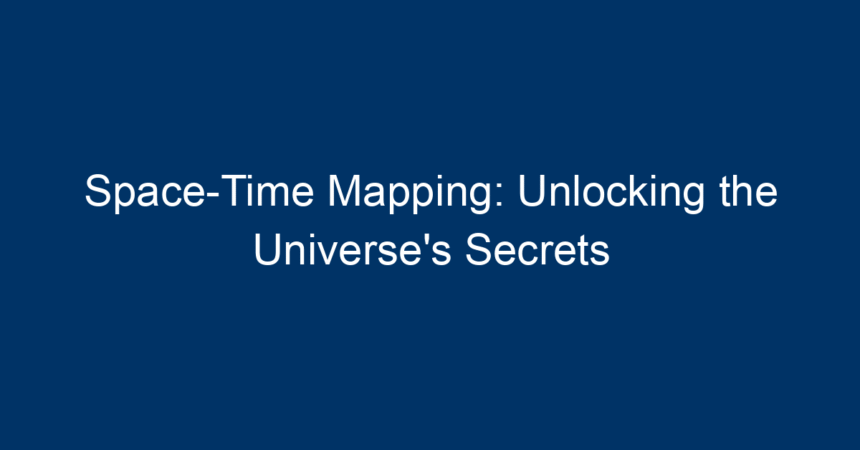Introduction
The cosmos has perpetually intrigued humanity, swirling with mysteries that challenge our understanding of reality. Among the many tools scientists utilize to unravel these enigmas, space-time mapping stands out as a revolutionary approach that integrates the dimensions of space and time into a cohesive framework. This meticulous method not only aids in deciphering the intricate workings of the universe but also expands our view of phenomena such as black holes, cosmic expansion, and even time travel. In this article, we will delve into the fundamentals of space-time mapping, explore its implications for physics and cosmology, and inspire a greater appreciation for the universe we inhabit.
Understanding Space-Time
What is Space-Time?
Before we dive into the specifics of space-time mapping, it’s important to understand what space-time itself is. Proposed by Albert Einstein in the early 20th century, space-time combines the three dimensions of space with the fourth dimension of time into a single four-dimensional continuum. In this framework, the location of objects and events is not merely defined in terms of spatial coordinates, but also in relation to time—a concept that fundamentally altered our perception of the universe.
The Role of Gravity in Space-Time
One of the most significant outcomes of the space-time theory is how gravity influences this continuum. Einstein’s General Theory of Relativity posits that massive objects like stars and planets warp the fabric of space-time, creating what we perceive as gravitational forces. This bending of space-time explains why planets orbit stars and why light bends around enormous objects, known as gravitational lensing. Through space-time mapping, scientists can visualize these distortions, providing insights into various cosmic phenomena.
Techniques in Space-Time Mapping
1. Gravitational Lensing
Gravitational lensing is a direct consequence of space-time mapping. When light from distant stars passes near a massive object, its path is bent. By observing these effects, astrophysicists can map the distribution of dark matter and understand the structure of galaxies. Advanced telescopes employ this technique to reveal hidden cosmic structures, including the elusive dark matter that constitutes a substantial portion of the universe.
2. GPS Technology
Closer to home, the Global Positioning System (GPS) is a practical application of space-time mapping. GPS satellites orbiting the Earth experience time differently due to their speed and distance from the planet’s mass. Engineers account for these variations—predicted by Einstein’s theories—to ensure accurate positioning data. This remarkable application of space-time mapping has revolutionized navigation, enabling everything from personal devices to military operations.
3. Quantum Mechanics and Space-Time
The intriguing relationship between quantum mechanics and space-time mapping is another frontier that scientists are exploring. Quantum entanglement, for example, suggests that particles can be entangled across vast distances, leading to questions about the fabric of space-time itself. Researchers are delving into how quantum states might be represented in a space-time framework, potentially unveiling new dimensions of reality.
Implications of Space-Time Mapping
Advancements in Cosmology
The evolution of space-time mapping is reshaping our understanding of the cosmos. By charting the expansion of the universe, scientists can infer pivotal details, such as the rate at which it expands—currently attributed to dark energy. Space-time mapping aids in elucidating the timeline of the universe’s evolution, offering opportunities to discover when and how galaxies formed.
Insights into Black Holes
Black holes have long fascinated astronomers and physicists alike. Through sophisticated mapping techniques, researchers can visualize the gravitational effects surrounding black holes, improving our understanding of their behavior. Observations of light bending around these regions denote extreme gravitational effects, providing tantalizing clues to their properties.
The Quest for Time Travel
The true wonders of space-time mapping extend into speculative realms, including time travel. While still largely theoretical, certain solutions to Einstein’s equations permit the notion of bending space-time to create shortcuts—wormholes—between two points in space and time. Though practical implementation remains a long way off, ongoing research continues to explore the implications of this tantalizing possibility.
The Future of Space-Time Mapping
Interdisciplinary Approaches
As we delve deeper into space-time mapping, an interdisciplinary approach emerges as a key player. Fields such as mathematics, computer science, and philosophy contribute unique perspectives that enhance our understanding of complex concepts. For instance, machine learning algorithms are being deployed to analyze vast datasets, enabling scientists to identify patterns and correlations previously thought impossible.
Citizen Science and Community Engagement
The rise of citizen science initiatives allows amateur astronomers and curious individuals to engage with the universe actively. These programs encourage contribution to ongoing research projects, such as analyzing light curves from distant stars or participating in extensive cosmic simulations. This democratization of knowledge nurtures a deeper public interest in space-time mapping and its implications.
Conclusion: Actionable Insights
Space-time mapping stands at the intersection of theory and empirical investigation, providing vital insights into the universe’s nature. As technology advances and our understanding of physics deepens, this dynamic field will undoubtedly unfold even more secrets of existence. From understanding the colossal forces that govern our universe to exploring humanity’s potential on the precipice of time travel, the implications of space-time mapping are vast and exhilarating.
Get Involved!
-
Stay Curious: Engage with scientific literature and popular science platforms to feed your curiosity about space and time.
-
Participate in Citizen Science: Join community projects to contribute to space research, such as the Galaxy Zoo or other astronomy-related initiatives.
- Educate Others: Share your knowledge about space-time mapping in discussions or social media. Helping others understand these concepts fosters a collective appreciation for the cosmos.
By taking these steps, not only do you nurture your enthusiasm for space-time mapping, but you also become a contributor to unraveling the mysteries of the universe. Every small discovery adds to the grand tapestry of existence, illuminating the profound connection between time, space, and the human experience.
Embrace the wonders of space-time mapping and embark on a journey that transcends the ordinary. Unlock the universe’s secrets, and discover your place within it!




